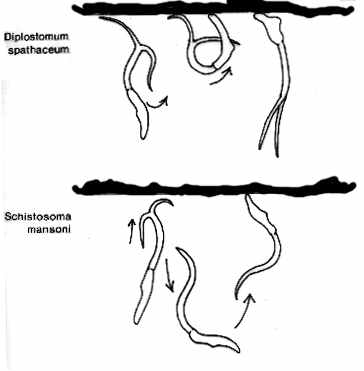Cercarial host-finding
 Cercariae are larval stages of trematode worm-parasites, which emerge from snail
intermediate hosts and infect other hosts. The cercariae of many species search and invade
their hosts actively. We have studied cercarial host-finding and host-recognition in 4
Schistosoma-species, which infect humans and mammals
(agent of human schistosomiasis), Trichobilharzia ocellata,
which invades its duck host, but accidentally also humans (agent of cercarial dermatitis), 4
species, which invade fish as next intermediate hosts, e.g.
Diplostomum spathaceum (the eyefluke of fish), and 4
Echinostomatid species, which invade water snails as next intermediate hosts.
Our results indicate the following common characteristics of cercarial host-finding (for
reviews see HAAS 1992, 1994):
Cercariae are larval stages of trematode worm-parasites, which emerge from snail
intermediate hosts and infect other hosts. The cercariae of many species search and invade
their hosts actively. We have studied cercarial host-finding and host-recognition in 4
Schistosoma-species, which infect humans and mammals
(agent of human schistosomiasis), Trichobilharzia ocellata,
which invades its duck host, but accidentally also humans (agent of cercarial dermatitis), 4
species, which invade fish as next intermediate hosts, e.g.
Diplostomum spathaceum (the eyefluke of fish), and 4
Echinostomatid species, which invade water snails as next intermediate hosts.
Our results indicate the following common characteristics of cercarial host-finding (for
reviews see HAAS 1992, 1994):
CHARACTERISTICS OF CERCARIAL HOST-FINDING AND HOST-RECOGNITION
-
Host-finding consists of sequences of behaviour phases.
Each phase may be independently stimulated by particular cues.
Many species achieve an unexpected high level of host specificity. The
specificity is achieved with different strategies:
- Chronological succession of responses to different stimuli
- Responses to a combination of different stimuli
- Responses to individual stimuli with an extremely high specificity and sensitivity
- There exists a high diversity of host-finding strategies.
Each species studied so far finds and identifies its host with mechanisms and in
response to host signals which differ considerably from those of other species, even
when these invade the samehost genera.
THE PHASES OF CERCARIAL HOST-FINDING
-
- Departure from the snail intermediate host and dispersal
- The swimming behavior and the orientation mechanisms (such as
responses to the environmental cues intensity and direction of light radiation and
temperature) are modified with age after shedding.
- Localization of and remaining in the hosts habitats
- The parasites select habitats, which are frequented by their
hosts with defined responses to the environmental cues intensity and direction of light
radiation, temperature and gravity.
- Localization in the hosts time
- Studies of other colleagues show, that cercariae emerge from their
snail hosts at that time of the day, when a contact with the hosts is most probable.
Emergence is synchronized by the photoperiod and temperature.
- Host directed orientation
- An approach towards the hosts occurs with very different
responses to host cues such as chemical gradients, dark stimuli, water currents or
touch.
- Attachment to the host
- The very different attachment behavior patterns are stimulated in
the various species by host cues such as chemicals, warmth, dark stimuli and´water
currents.
- Remaining on the host (enduring contact)
- Most species remain on their hosts only, when the attachment
stimuli are followed by other host cues such as chemicals, warmth and hydrophobicity.
- Creeping to entry sites
- The entry sites are searched by responses to certain chemical and
thermal gradients.
- Penetration into the hosts skin
- Penetration consists of another sequence of behavior phases such
as penetration movements, shedding of the tail, transformation of the body wall for
immune evasion and secretion of enzymes. Each of these phases can be stimulated by very
different chemical components, warmth and hydrophobicity.
- On the job:
Wilfried Haas,
Tina Loy,
Petra Stiegeler,
Cynthia Wulff,
Bernadett Beran,
Sebastian Brachs
 Homepage
Homepage
 Cercariae are larval stages of trematode worm-parasites, which emerge from snail
intermediate hosts and infect other hosts. The cercariae of many species search and invade
their hosts actively. We have studied cercarial host-finding and host-recognition in 4
Schistosoma-species, which infect humans and mammals
(agent of human schistosomiasis), Trichobilharzia ocellata,
which invades its duck host, but accidentally also humans (agent of cercarial dermatitis), 4
species, which invade fish as next intermediate hosts, e.g.
Diplostomum spathaceum (the eyefluke of fish), and 4
Echinostomatid species, which invade water snails as next intermediate hosts.
Our results indicate the following common characteristics of cercarial host-finding (for
reviews see HAAS 1992, 1994):
Cercariae are larval stages of trematode worm-parasites, which emerge from snail
intermediate hosts and infect other hosts. The cercariae of many species search and invade
their hosts actively. We have studied cercarial host-finding and host-recognition in 4
Schistosoma-species, which infect humans and mammals
(agent of human schistosomiasis), Trichobilharzia ocellata,
which invades its duck host, but accidentally also humans (agent of cercarial dermatitis), 4
species, which invade fish as next intermediate hosts, e.g.
Diplostomum spathaceum (the eyefluke of fish), and 4
Echinostomatid species, which invade water snails as next intermediate hosts.
Our results indicate the following common characteristics of cercarial host-finding (for
reviews see HAAS 1992, 1994):